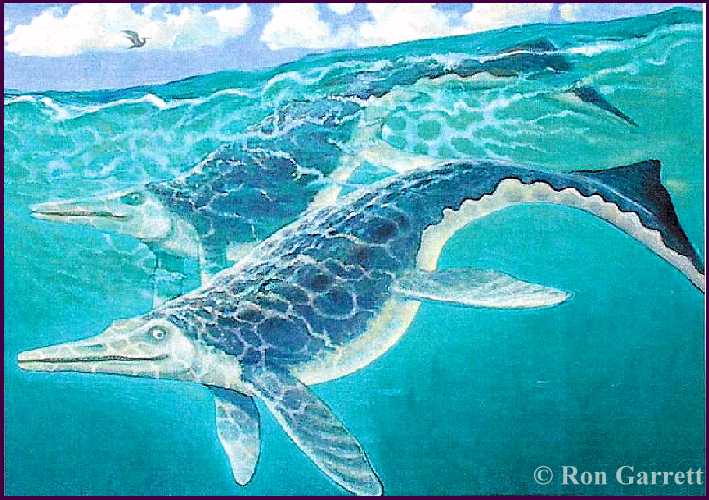According to local accounts, the first bones of Shonisaurus popularis
were found near the mining town of Berlin, Nevada about 1869. Stories are told of miners
using the large, round vertebrae as dinner plate but these stories are apparently
unsubstantiated (See Note at bottom of the page). It
seems to be a very unlikely place to find fossils of anything, let alone a group of
50-foot long ichthyosaurs laid out on the side of a mountain, at an altitude of over seven
thousand feet in the middle of a desert!
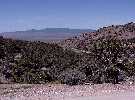 |
The picture at left shows a view
looking west from the main parking area at the ichthyosaur shelter. In 1928, Professor S.
M. Muller of Stanford University was the first to identify the fossils as ichthyosaur
remains. It wasn't until 1953, however, that Dr. Charles L. Camp (right, center)
and Dr. Samuel Wells of the University of California, Berkeley began to excavate the
site. In all, the partial remains of at least 37 adult ichthyosaurs have been located. It
is not yet certain how these large creatures died and were buried together in such a small
area. |
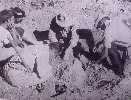 |
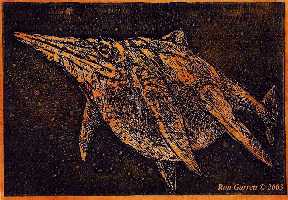 |
One early theory holds that they
represent a school of ichthyosaurs that were beached and died together like a group of
stranded whales. Another is that they were trapped in a shallow embayment and died
one by one over a longer period of time. The latest theory and most likely theory is that
they died and were buried in a deep ocean shelf environment. In any case, the skeletons
are generally oriented along a north-south axis, suggesting that currents or tides played
some part in deciding their final resting place. Most of the skeletons are incomplete,
with the most easily detachable parts missing. The condition of some remains suggests
scavenging or an extended exposure to the elements, while others appear to have been
buried relatively rapidly. LEFT: Paleo-art by Ron Garrett - Copyright © 2003 by Ron Garrett. Used with permission.
MORE
SHONISAURUS PALEOART BY: Walter Meyers |
All of the remains, except one, are still in place
where they were found. One specimen was removed and put on display at the Nevada State Museum in
Las Vegas. Most of the 36 others were covered and protected for later
study. The remains of 8 or 9 individuals are safely exposed inside the
ichthyosaur shelter that is open year-round. The site became the Berlin-Ichthyosaur
Park in 1970 (for more information on the Park, CLICK HERE). It is located about
100 miles southeast of Fallon,
Nevada near the old mining town of Berlin.
The geology of the area is complex to say the
least. Now in the middle of a dry, sage brush covered desert, it is hard to imagine
that 200 million years ago an ocean covered these rocks, or that hundreds of thousands of
dollars worth of gold and silver were mined next to the fossils of these giant marine
predators.
 |
At more than 15 meters (50+ feet in
length, and 40 tons, Shonisaurus popularis was for many years the largest known
ichthyosaur in the world, and is still the largest ichthyosaur known from the United
States. The
recent recovery of the remains of a 23 meter-long ichthyosaur in Canada has
dramatically shown that even larger marine reptiles have existed but does not take away
from the paleontological importance of these large, late Triassic ichthyosaurs. The
human standing beside the sculpture (me) appears to be about bite size. (Larger photo here) |
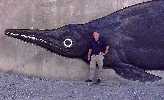 |
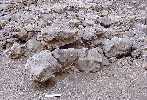 |
At one of the larger exposures, a
number of large vertebrae were found eroding from the side of Union Canyon in the Shoshone
Mountains at an altitude of about 7000 feet above sea level. The current ichthyosaur
shelter was built over the site in 1966 to protect the fossils from further weathering. |
 |
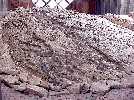 |
The shelter encloses a number of
partial ichthyosaur skeletons, most notable of which is a large, nearly complete individual that stretches
nearly the full length of the exposed rock surface inside the building. In these pictures,
the head of the animal would be at the bottom of the picture, with the vertebral column
going upward toward the top of the picture. The animal was preserved laying on its
stomach, with it's skull dislocated and laying at an angle of greater than 90
degrees to the right of the vertebrae. |
 |
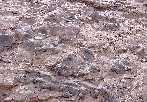 |
This picture shows parts of the 3
meter long skull of the above individual. The bones are in relatively poor condition
and are not readily recognizable in this picture. |
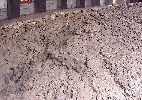 |
In this view of the same area, the
vertebrae of another ichthyosaur are laying across the first set of remains. Dr. Camp
originally believed that several species of ichthyosaurs were found at this site, but
there is general agreement now that all are Shonisaurus popularis. |
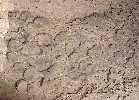 |
Shot from above and looking down,
this pictures shows the dorsal vertebrae and pelvic bones of another large ichthyosaur.
The tail of the animal continues below the path at my feet. Several ribs are
visible at the upper right of the picture. The bones labeled "J" are probably
the right and left femurs. Unlike most later ichthyosaurs, the front and hind limbs
of Shonisaurus were approximately the same size. Also, the 'tail-bend' in Shonisaurus
is much less than in later ichthyosaurs. |
 |
This is a closer view of the pelvic
region of the same individual with a 15 cm (6 inch) ruler included for scale. |
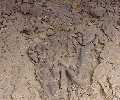 |
In this picture, you are looking from
the tip of the snout to the back of the skull (3 meters or about 9 feet) of a third
ichthyosaur. None of the skulls are complete, or in good condition. The vertebrae of the
neck are visible at the top left and some limb bones are at the top right of the picture. |
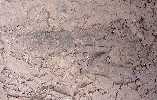 |
Another view of the same skull. |
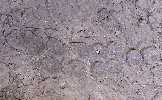 |
A mixture of vertebrae and rib
fragments. The vertebrae are 15-20 cm (6-8 inches) in diameter. |
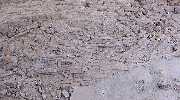 |
The thoracic ribs of fourth
individual located near the top of the exposure. Some of the ribs are almost 3
meters (nine feet) long. A series of vertebrae is visible in the left side of the picture. |
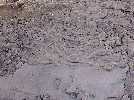 |
A slightly different view of the same
set of ribs. |
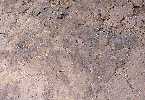 |
Another assortment of ribs and limb
bones. |
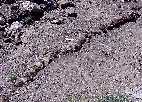 |
Outside the shelter, a 4 meter (12+
feet) long string of caudal vertebrae are on display where they were found. The
scale in the picture is 15 cm (6 inches). |
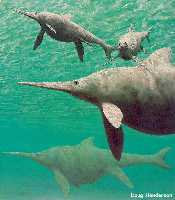 |
Two views of the late Triassic ichthyosaur, Shonisaurus
popularis.... in life, and death, by Doug Henderson. Copyright © Doug
Henderson; used with permission of Doug Henderson. While some fetal
material may have been found in association with the adult ichthyosaurs at the Berlin
site, all of the remains appear to represent adult or near adult individuals.
For more of Doug Henderson's paleo-life art, visit his Oceans of Kansas Page or his Earth History Illustrations website. |
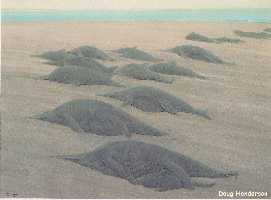 |
| Comments by Brad K. from the Marine Reptile Forum (May,
2008): It is great to get some discussions on ichthyosaurs going, I
thought I would post some comments related to Mike’s comment about being hard to
believe S. sikanniensis being larger than the wall at Berlin-Ichthyosaur State
Park. And to comment on some myths about the ichthyosaurs of the park.
The ichthyosaur modeled on the wall that Mike is standing by is actually not that out of
line for representing the size of the larger S. sikanniensis. S. sikanniensis
is reported to be 21 meters in length and while the wall at BISP by which Mike is standing
is about 17 meters (56 feet), the section Mike is standing by could be an easy
representation of what is now the largest ichthyosaur. The wall is oversized for S.
popularis, the specimens on the visitors quarry is would estimate to range from 11.5
to 14 meters., S. popularis probably did reach 15 meters based on other
partial skeletons found at the park. (There have been excavations at ten
different sites and over 25 locations at the park for identified for monitoring).
Reports for S. popularis have ranged from 15 meters up to 21 meters in early
descriptions, the wall was designed during the early period when they were thought to be
larger. Camp downsized his original estimates as he studied his material,
primarily by reducing his estimate of tail length.
The skull for S. popularis would not have been larger that about 2.75 meters while
the skull on the wall is about 3 meters. An 3 meters is the estimated size for the
skull of S. sikanniensis (which had early reports of being 5 meters), -
making the wall a good representation of the larger S. sikanniensis.
The centra for S.sikanniensis are reported to be about the same width or diameter
as S. popularis, but as being longer which gives rise to it being a longer animal.
Although I believe S.sikanniensis is significantly larger than S.
popularis, but I also believe there is a good chance that the estimate of 21 meters,
which is an in the ground estimate, might end up also being reduced with additional
studies. Although that is more of a hunch on my part rather than based on any real
evidence. The centra do not seem that much larger, and the skull was reduced
from the original in the ground estimate. For now I fully accept Dr. Nichols
estimate of 21 meters.
It is unfortunate the Dr. Nichols could not complete her work on this specimen. Just
as it was unfortunate that circumstances did not permit Dr. Camp to complete his work
properly. Camp was doing great work when the park was a independent monument, but
when it came under the authority of the State Park Commission he was treated poorly, a
feud played out through newspaper editorials that meetings with the Governor could not
resolve, and he quit work at the park for some time. With a change of administration
he came back to some plaster jackets that were starting to deteriorate in the field and
continued his work, but he never had the enthusiasm for the work of earlier years.
Dr. Camp never actually finished his work, and it was completed by Dr.
Gregory.
I think this would be a good time to mention a couple of falsehoods that have become
associated with the ichthyosaurs at BISP.
First is the matter of beaching. Dr. Camp is the only person who has studied at the
park that believes the animals beached themselves. Dr. Sam Welles did not
agree with that interpretation when he worked there in 1984 and did advise me that he
thought Dr. Camp had begun to accept that they were not beached, but we will never know
for sure. Studies of the geology by Dr. Norm Silberling, and PhD dissertations
on taphonomy by Dr. Jennifer Hogler, and on potential upwelling in the Luning Formation by
Danielle Montague-Judd, as well as other geologists who have reviewed the area all agree
that the sediments represent, as written by Dr. Silberling " a continuous increase in
the depth of water and distance to the shoreline during the deposition of the shaly
limestone member is indicated by its lithologic character and fauna".
For those not familiar, Dr. Camp started excavations in 1954 and published an account, in
the first year of excavations that proposed the animals died by beaching. Camp
based his idea on the large size, close spacing and nearly parallel orientation of the
specimens. He suggested that the animals were feeding inshore at high tide and were
grounded by a rapid drop in sea level, the largest animals were trapped and died after a
vain struggle for freedom. After death wave action rolled each carcass
parallel twisting the skull back along side of the body. And somehow an evaporation
process left layers of calcite deposits above the bone layer which he called an
evaporating basin.
It was a good story for the park as it leaves an image similar to the beaching of whales
today and provides visitors with a vivid image of how they died. However, there is
no data to support Dr. Camp's scenario of stranding. First of all, there are
ichthyosaur bones through about 800 meters of the Luning Formation at the park and the
depositional nature of the skeletons as well as the nature of the sediments and other
fauna are not the same throughout the formation. Only a couple hundred meters
actually has articulated skeletons. Ignoring the shaly limestone matrix and the
abundant associated invertebrate fauna, the skeletons themselves, being fairly well
articulated, themselves do not support being deposited in active shore/tidal zone
conditions. Also, the calcite layers which Dr. Camp considered to be remnant of some
sort of evaporative basin, clearly follow fractures and are not of evaporative origin.
The beaching scenario needs to be abandoned in describing the quarry
and ichthyosaurs at the park. They were primarily deposited in relatively
quiet deeper-water sediments. I would expect that Shonisaurus, was much more
likely to have fed away from the shoreline in much deeper water than a shallow tidal
waters.
The next myth is a story that has developed in the last fifteen years - that the miners
used the centra as dinner plates. This story is first published in an issue of
California Geology in 1988. It cites Dr. Camp, but Camp never made such a comment.
It has been a very popular account, told by Rangers at the park, and
published in almost every story these days. But it is false, probably an enhancement
based on Camp’s reference to the size of the eye being as large as dinner plates.
Actually, evidence indicates that the miners did not even know about the
fossils. A couple of decades ago I was able to talk with several persons who lived
in Union Canyon and they did not know about the ichthyosaur fossils. They were only
aware of the invertebrates. There are also some other written documentation..
Miners did discover the ichthyosaurs, Cymbospondylus, from the West Humboldt
Mountains and the two stories are often blended, especially in early years.
Brad |
References:
Camp, C. L. 1981. Child of the rocks - The story
of the Berlin-Ichthyosaur State Park. Nevada Bureau of Mines and Geology, Special
Publication 5, 36 pp.
Dupras, D. L. 1988. Ichthyosaurs of California,
Nevada and Oregon. California Geology (May) 99-107.
Hogler, J. A. 1992. Taphonomy and paleoecology of Shonisaurus
popularus (Reptilia: Ichthyosauria). Palaios. 7:108-117.
Kosch, B. F. 1990. A revision of the skeletal
reconstruction of Shonisaurus popularis (Reptilia: Ichthyosauria). Journal
of Vertebrate Paleontology 10(4):512-514.
McGowan, C. and R. Motani. 1999. A new
interpretation of the Upper Triassic ichthyosaur, Shonisaurus. Journal
of Vertebrate Paleontology 19(1):42-49.
Motani, R. 1999. Phylogeny of the Ichthyopterygia.
Journal of Vertebrate Paleontology 19:472-495.
Nicholls, E. L. and M. Manabe. 2004. Giant ichthyosaurs of the
Triassic - a new species of Shonisaurus from the Pardonet Formation (Norian: Late
Triassic) of British Columbia. Journal of Vertebrate Paleontology 24(3): 838-849.
Orndorff, R.L., R. W. Weider and H. F.
Filkorn. 2001. How the West was swum. Natural History 110(5):22-24 (Adapted
from Orndorff, R. L., R. W. Weider and H. F. Filkorn, 2001. Geology Underfoot in
Central Nevada, Mountain Press Publishing, Missoula, MT.
Other Ichthyosaur Webpages:
Ryosuke Montani's
Ichthyosaur Page Baptodon in Wyoming

